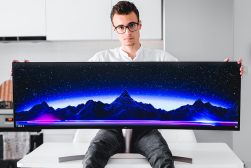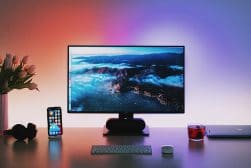Stuck Pixel Fixing Guide (How to Diagnose, Fix & Prevent)
Concerned about stuck pixels (or dead pixels) on your monitor? Learn how to diagnose, fix and prevent them from happening again in this helpful guide.
Learn | Photography Guides | By Ana Mireles
Can you fix a stuck pixel on your computer LCD monitor or laptop screen?
Yes, absolutely! This guide will show you how.
If you’ve ever wondered if stuck pixels are permanent or if dead pixels spread or go away, you’ll find all the answers right here.
(Spoiler alert: You can fix a stuck pixel, but you can’t fix a dead pixel!)
We’ll also have a look at how stuck pixels happen in the first place and how to prevent them.
Time to fix your screen – let’s get stuck into the tutorial!
How to Fix a Stuck Pixel on an LCD Monitor
If you are dealing with pesky dead pixels on a monitor, here’s how you fix them.
You may experience a stuck pixel on a new or used LCD screen. If your monitor’s warranty has expired, or the manufacturer won’t replace the monitor because it considers one or two stuck pixels as acceptable, there are a few things that you can do.
I’ll tell you about a few methods to fix stuck pixels in order of risk, although only rub or tap methods could actually cause damage.
Keep in mind that none of these methods is completely foolproof.
However, they should help out in most situations, and therefore you might want to give them a try before you spend your money calling a specialist or decide on getting your monitor replaced.
Method #1: Wait and see.
A dead pixels on monitors can be quite annoying. Fortunately, they resolve on their own quite often. This is obviously the safest method, but it’s not always effective. If you recently discovered a stuck pixel, you can try to turn off the monitor and unplug it for a day or two. When the damage is caused by overuse, this could help.
Other times stuck pixels get fixed on their own, or at least they can be less noticeable because they get less bright.
So, if it’s not too annoying for your work, you can try to wait it out and see if anything improves.
More often than not, you don’t need a dead pixel fixer at all.
Method #2: Pixel fixing software
Here’s how to fix dead pixels if you’re tired of waiting it out.
There are many websites that offer a stuck pixel fixing service. They work more or less in the same way, by flashing pixels and hopefully un-stick the ones that are defective.
You’ll find that many of them run with Flash, which is no longer available – fortunately, here’s one that you can still rely on – JScreenFix.
JScreenFix is a free online service that can solve your problem of stuck pixels. You don’t have to download anything, so it’s not invasive nor harmful.
Visit the website jscreenfix.com and scroll down to find the Launch JScreenFix button – click on it. It will open a black screen with a square full of flickering pixels. The instructions pop up right there – however, what you’re meant to do is drag this square to the area where the stuck pixel is. Then, leave it for at least ten minutes.
If it doesn’t fix your stuck pixel on the first try, you can do a few attempts leaving it for a little longer. Usually, this method gets the job done, but it’s not a 100% guarantee.
How Much Do You REALLY Know About Photography?! 🤔
Test your photography knowledge with this quick quiz!
See how much you really know about photography...

*Safety note: If you have epilepsy, you should avoid using any of these stuck pixel fixer websites or software as they work with flashing erratic lights.
Method #3: Apply pressure
Any technique that implies applying pressure to fix a stuck pixel can potentially make more damage than good. Here you’ll find some precautions you should take to minimize these chances.
However, if you decide to do this, it’s at your own risk.
- Turn on your computer screen or monitor as the pixel needs to be working for the pressure methods to stand a chance.
- Determine if you have hot, stuck or dead pixels – if you don’t know the difference among these, read the next section first. Only if the pixel is stuck, you’ll have a chance at fixing it with a pressure method.
- Open a black image as background in full-screen mode or use a black browser window such as this. Either way, don’t just leave a blank signal. This again has to do with the fact that you need the pixel to have the backlight on. Make sure the screen is clean to avoid confusing dust with bad pixels.
- Get a Stylus or Touch pen to put pressure on the monitor without damaging it. Otherwise, you can try using your finger wrapped with a microfiber cloth.
- With whatever instrument you decide to use, gently press the area with the stuck pixel and rub it for a few seconds – then remove pressure.
- If it’s not working, you can try to apply just slightly more pressure. Be careful not to press too hard, or you can worsen the problem.
- You can also try to combine methods and apply gentle pressure while you’re running pixel fixing software.
Some people recommend a heat method where you use a hairdryer to warm the spot while you’re putting pressure on the monitor to fix a stuck pixel. Others suggest using a hot water damp cloth to apply the heat directly.
However, you could end up with something worse than a stuck pixel. The pressure method already represents a small risk of damaging your monitor – if you add heat, you’re increasing that risk.
Dead Pixel vs Stuck Pixel – What’s the Difference?
To understand the possible pixel problems that you can face – and whether or not you can fix them – you need to know that an LCD screen is made by pixels. Three sub-pixels form each pixel – one is red, one is green, and one is blue (RGB).
When you have a pixel defect, it means that one or more of the subpixels aren’t working as they’re supposed to. Let’s see how these can present.
- Dead pixels
Dead pixels show no light, and what’s the absence of light? Dark. So, if you see a black pixel on your monitor, it’s a dead pixel. These are more noticeable when you’re working with a white background. If you are asking “Do dead pixels go away” the answer is no, BUT what you might think is a dead pixel might just be stuck.
- Stuck pixels
A stuck pixel is when one or two of the subpixels is always on. So, if you have a color dot – it means that you have a stuck pixel. What causes stuck pixels can vary but the most common cause is faulty transistors. They are either stuck on the on or off phase.
- Hot pixels
The third option is that you see a white pixel – these are known as hot pixels. That means that all three colors (red, green and blue) are always on – this results in white light. These are more obvious on a dark background.
What Causes Dead or Stuck Pixels?
So, now you know what type of faulty pixels you can run into and how you can identify them. At this point, you might be wondering how do stuck pixels happen?
To understand how a hot, dead, and stuck pixel occurs, let me start by explaining how a monitor works.
LCD stands for liquid crystal display. These monitors are made with multiple layers. In the far back, they have the light source that illuminates the screen with white even light.
The reason why we don’t see a fully white screen all the time is that there’s also a layer with color filters. This layer has a red, green and blue filter per pixel (RGB) – each of those would be a sub-pixel.
Depending on which one of these sub-pixels are visible at a given time, you see different color pixels.
To control which one of those pixels and sub-pixels are on and how bright they are, LCD monitors have other layers to block certain light.
Two of these ‘blocking’ layers are polarizing filters – the first one filters the light waves in one orientation and the second one in the opposite direction.
Then, the liquid crystals in between modify the orientation of the light to determine which one passes through the polarizing filter.
They can do this according to the amount of voltage. No voltage means that light can pass – full voltage blocks the light. Everything in between allows a different amount of light to pass through.
I know it doesn’t sound very easy, but you can see the explanation with diagrams in the YouTube video above if you need to.
Anyway, all this explanation is to tell you that stuck or dead pixels often happen because there is a broken transistor that fails to supply voltage to a certain pixel or sub-pixel.
Keep in mind that there are two types of LCD monitors: TN (Twisted Nematic) and IPS (In-Plane Switching). On TN monitors, the default without voltage is on. So, if the transistor is not supplying power, the pixel won’t be dead (black) but hot (white). On IPS monitors, it works the other way around.
Most of the times, the damage in the transistor is a manufacturing defect. However, it can also happen because the monitor falls or it suffers physical damage.
All LCD displays are susceptible to this type of damage – it can be a monitor, a laptop, a smartphone or a TV.
How do you Check for Dead Pixels?
Dead pixels on phones or monitors can be quite the bummer. As mentioned before, a dead pixel is a black spot on your computer and LCD screen. The easiest way to spot them is on a completely white screen.
So, you can use a dead pixel test. There are some free ones online such as the one from LCD Tech. You simply need to click on the Start Test button, and it will automatically enter full-screen mode in complete white.
There are dead pixel test apps for iOS and Android if you want to check your smartphone screen for dead or stuck pixels.
Make sure your monitor is clean to identify dead pixels better. Because the screen will be completely white, you can also use this to find stuck pixels. On the other hand, a hot pixel won’t be visible – for these, you would need a dark screen.
How to Prevent Stuck Pixels
Sometimes you can have bad luck and receive your new computer or monitor with an original pixel fault. In most cases, these are dead pixels, and therefore, there’s nothing you can do except try and exchange your monitor with the manufacturer.
Stuck pixels can be prevented with the use of screensavers that constantly change the voltage that each pixel receives.
Also, turn off the display whenever you’re not using it. You can get into the habit of manually putting it to sleep or turn it off when you’re stepping away from it.
Otherwise, you can use automatic functions to put the monitor in standby mode after a certain period of inactivity.
Keep in mind that these are just good practices that can extend the life of your LCD screen. Unfortunately, there isn’t a full-proof method to avoid getting stuck pixels.
FAQs about Stuck Pixels & Dead Pixels
Are stuck pixels permanent?
Stuck pixels are the most fixable problems you can have with your pixels. A stuck pixel can disappear on its own, or you can use other methods to try to fix it – in this article, you’ll find some of them.
What causes dead pixels?
Dead pixels on screens can be caused by a lot of factors but the most common one is manufacturing defects or the electronics failing.
What does a dead pixel look like?
A dead pixel on monitors is easy to identify. They can be one or two dots that don’t change color and appear stuck. They can either be white, black, or other color.
Is 1 dead pixel acceptable? (Is one dead pixel bad?)
It depends on the class of monitor that you have – only class I monitors shouldn’t have any dead pixels. For other classes, most manufacturers will consider one dead pixel as acceptable. This means that they probably won’t replace your new monitor because of it.
Of course, if this acceptable to you, it’s a different matter. It often depends on the location of the dead pixel and the size of the monitor. If you find it unacceptable, you should still give it a shot at the guarantee and see if you can have it exchanged. Check the ISO 13406-2 to see the ‘acceptable’ standards according to the type of monitor.
Will dead pixels spread?
Normally not. If you notice they are spreading – call a specialist to determine what is the problem and whether it can be fixed.
Will dead pixels go away?
No, dead pixels won’t go away on their own – most of the times, they’re not even fixable. Before you give up, though, make sure the pixel is really dead and not stuck – because stuck pixels can go away.
Can dead pixels be fixed?
In most cases, there is no dead pixel fix. Most modern screens and monitors are not designed to be easily serviceable. Your best bet might be to get yourself a new monitor.
Do dead pixels spread?
Dead pixels are normally isolated cases and don’t usually spread. If they do spread, you need to call customer service for your device or replace your device entirely.
How big is a dead pixel?
It depends on the size of the monitor and the resolution. The higher the resolution – the smaller the pixel.
How noticeable are dead pixels?
Dead pixels are more noticeable in light areas because they are black. Also, it depends on the size of the pixel, the size of the display and the resolution. Keep in mind that once you know it’s there, you’ll keep noticing it.
Final Words
In conclusion, having a hot, stuck or dead pixel in your LCD screen is very common in most consumer-level displays and monitors.
If your warranty is valid and you can get your device exchanged, that’s the best way to do it. Otherwise, determine what type of pixel problem you have.
There are a few different methods to try to fix stuck pixels – although none of them is certain. On the other hand, hot and dead pixels can’t be fixed.
I hope you found this guide helpful. If you have any questions or want to share some tips on preventing, detecting, and fixing faulty pixels, please leave a comment.

Check out these 8 essential tools to help you succeed as a professional photographer.
Includes limited-time discounts.












